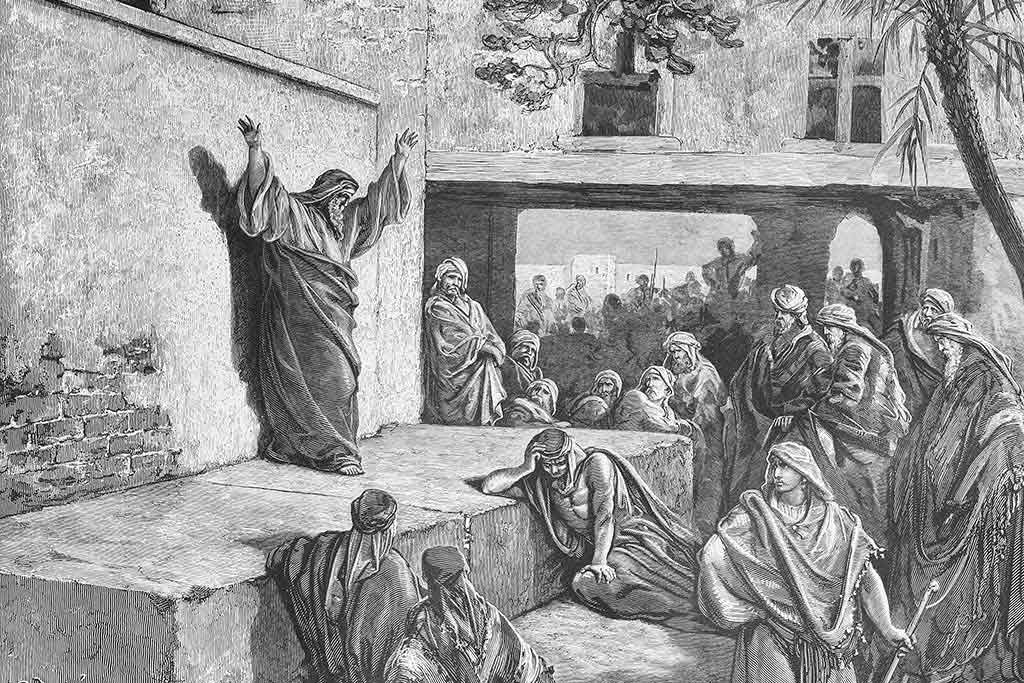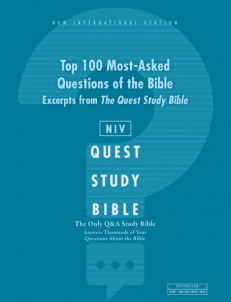
Where Should I Start Reading the Bible?
Many new and seasoned Christians have a story about their attempts to read the Bible cover to cover that goes something like this: “It was going great as I read through Genesis and Exodus, but somewhere in Leviticus or Numbers, I started to get bogged down in details I didn’t quite understand. And by the time I hit Deuteronomy, I was done.”
While it’s true that “all Scripture is God-breathed and is useful for teaching, rebuking, correcting and training in righteousness” (2 Timothy 3:16), the Bible is not like any other book. While a person who’s approaching the Bible intending to read it through can certainly try to read it from front to back, it isn’t necessarily intended to be read that way. In fact, the Bible can actually be seen more as a library than just a single book.
The Protestant Bible is comprised of 66 books, and many of those books are written in a variety of different genres or types of literature. There’s no need to be intimidated by this idea, as it’s similar to the different types of music we listen to: we approach classical music differently than we do classic rock or rap, listening to one type for one reason and the other types for other reasons. In the same way, the Bible’s different literary genres all need to be read with a little different approach. Starting to read through the Bible at Genesis 1 and trying to read straight through without having a specific strategy can get frustrating if we don’t know how these books and their literary genres work together.
So let’s start by looking at what these literary genres are. There are a few ways to classify the genres of the Bible, but they typically fall into these categories.
Historical narrative
Books include: Genesis, Exodus, Leviticus, Numbers, Deuteronomy, Joshua, Judges, Ruth, 1 and 2 Samuel, 1 and 2 Kings, 1 and 2 Chronicles, Ezra, Nehemiah, Esther, Jonah, Acts
While most of the Bible’s books have some element of history to them, these are the ones that are primarily focused on communicating stories of historical significance. In these books, we’ll find a lot of the Bible stories we probably heard when we were kids.
They focus mainly on the story of the Israelite people: the people whom God chose to be in a special relationship with him, and through whom his plan to redeem the world came to be. This is the line of characters and stories that underpin the stories of the New Testament—the people and places we read about form the background to the stories of Jesus and the early church. While these long historical documents can be a little difficult to read, taking them on with an eye toward understanding the story of Jesus makes them a fascinating study.
Wisdom literature
Books include: Job, Proverbs, Ecclesiastes
Wisdom literature focuses on what it means to live well. Some of the language is poetic and figurative, so it can’t always be read in the same way that we would read the Bible’s historical books. For instance, Proverbs 13:14 tells us that “the teaching of the wise is a fountain of life . . .” This doesn’t mean that wise teaching is a literal fountain, but rather a continuing source of intellectual and spiritual nourishment.
When we read through the wisdom books, we can find divine instruction, hope, encouragement, and insights for practical daily living. The book of Job is a well-known work that explores humanity’s relationship with suffering and God’s part in walking with us through our earthly experience, as fraught as it is with complexity, anxiety, difficulty, and sorrow. This book and the brief account of the Teacher in Ecclesiastes can provide us with an amazing and healthy perspective on our lives as they are lived every day in God’s presence. Life is hard; God is so, so good.
A walk through the 31 chapters of Proverbs can also fortify our daily lives as we select one chapter to read per day of the month. The practical instruction that we receive from this book is amazingly relatable to whatever situation we encounter as we try to follow in the path of Jesus.
Poetry
Books include: Psalms, Song of Songs, Lamentations
While many Old Testament books contain portions of poetry, these three books are written as verse. Unlike English poetry that focuses more on rhyme and meter, Hebrew poetry creates an emotional impact by focusing on balanced, parallel lines and repetition to emphasize emotion.
We can see an example of this in Psalm 24:3-4 where we’re told,
Who may ascend the mountain of the LORD?
Who may stand in his holy place?
The one who has clean hands and a pure heart,
who does not trust in an idol
or swear by a false god.”
Both verses use repetitive lines to drive the point home. To ascend to the mountain of the Lord and stand in his holy place both communicate a blamelessness before God; faithfulness is communicated by the comparable ideas of not trusting in idols or swearing by false gods.
Many people who find themselves in difficult circumstances turn to the Psalms, where King David and other writers were at their most raw and honest with their heavenly Father. The pleading and praises we see in many of these beautiful songs connects and resonates with our deepest emotions.
The Song of Songs is a fascinating look at the relationship between a king and his bride; many scholars have tried to relate this short poem to the relationship of Jesus to the church, so it can be read on many different levels.
The book of Lamentations follows the book of Jeremiah. It leads people through a difficult time in the history of the Israelite nation and is a fascinating study in how we can relate to God when faced with our own sins and their consequences.
Prophecy
Books include: Isaiah, Jeremiah, Ezekiel, Daniel, Hosea, Joel, Amos, Obadiah, Micah, Nahum, Habakkuk, Zephaniah, Haggai, Zechariah, Malachi
The Bible’s prophetic literature focuses on God’s word spoken through his prophets. These messages tend to emphasize Israel’s need to repent before they experience the Lord’s judgment. When reading prophecy, it’s essential to understand who God is talking to through his spokespeople and the overall message he is trying to convey.
When looking at these historical accounts, take the time to ask yourself, “How does what I’m reading relate to the world I see today?” While there are not direct correlations necessarily to be found, the indirect correlations are abundant.
We also see in these books some incredible references to Jesus’ birth, death, and resurrection to which we need to pay particular attention (particularly, but not exclusively, in the book of Isaiah). These prophets, writing hundreds of years before the birth of Jesus (Luke 2), predicted fascinating things about Jesus’ life, death, and resurrection that could point to only one individual throughout history: Jesus, the promised Messiah.
These inspired books can also teach us in very practical ways what the blessings of obedience to God’s Word and his way look like.
Apocalyptic literature
Books include: Daniel, Revelation
Like some of the Bible’s prophetic literature, the apocalyptic writings focus on future events in the life of the author. Some of what we read about in these books has already been fulfilled; other ideas that we encounter can only be fulfilled at the end of time.
Because so much apocalyptic literature involves dreams and visions translated into symbols and imagery, this is often the most difficult genre to understand—and the easiest to misinterpret. Witness the many books written about the end times and the individuals—some well-meaning and some not so much—who have predicted specific dates for these events to happen.
Each book of apocalyptic literature has many fascinating images that fire the imagination and that in and of themselves inspire wonder and praise in the hearts of people who read and study them. (Spoiler alert: in the end, God wins.)
Gospels
Books include: Matthew, Mark, Luke, John, Acts
Sometimes the Gospels get lumped in with the historical narrative books of the Bible, and that makes sense. After all, their entire value rests on the truths of their historic accounts. But what separates them into their own genre is that the Gospels focus on the life, death, and resurrection of Jesus—the story that has transformed the entire world and given hope to billions of people over the last two-thousand-plus years.
While all four Gospels concentrate on the life of Jesus, they each have a unique emphasis or reason for telling their story. Consequently, each one approaches the story of Jesus differently. The Gospels of Matthew, Mark, and Luke are called “synoptic” gospels. That’s just a fancy way to say that they all tell the story of the life of Jesus using the same accounts, although they each also cite different episodes that the other writers leave out, giving us a more complete picture of the life and ministry of Jesus on earth.
The Gospel of John is not one of those synoptics, as it examines primarily who Jesus said he was—the only individual in history who was both fully God and fully human at the same time—what Jesus’ purpose was on earth, and how he accomplished it.
Luke’s Gospel and Acts are both technically epistles (in that they are letters to a specific recipient), but they revolve around the Messiah and his establishment of the early Christian church, so they also fall into this literary genre.
As has been mentioned already, the stories in these books hold the key to the hope of the world, because in them, in a way that the Bible’s other literary genres don’t provide, we get to meet and come to know Jesus the Savior in a unique and wonderful way.
Epistles
Books include: Romans, 1 and 2 Corinthians, Galatians, Philippians, Colossians, 1 and 2 Thessalonians, 1 and 2 Timothy, Titus, Philemon, Hebrews, James, 1 and 2 Peter, 1,2 and 3 John, Jude
Epistles are letters, and like modern letters, they’re made up of a greeting, a body of text, and a closing. These letters focus on instruction, correction, and encouragement for the new first-century churches that were established as Jesus’ disciples spread word of his life, death, and resurrection to a world that desperately needed to hear that story.
The primary author of these letters is the apostle Paul, who was known as the “evangelist to the Gentiles” (non-Jewish peoples). He exerted arguably his greatest influence when he was locked in prison, where most of these letters were penned to their waiting audiences.
Through these fascinating letters we learn, in a very practical sense, how to live our daily lives as followers of Jesus. Paul wrote to believers who were just like us: They wanted to know more about how Jesus’ life and teachings could impact their daily lives.
Reading through these letters exposes us to the wisdom of the ages written by individuals who had direct, first-person contact with our Savior, Jesus, while he walked the earth. Keeping that in mind when approaching these letters gives them an urgency and an applicability that can completely transform who we are and how we see life in this world and in relationship with others.
Some books have multiple genres
There’s definitely some genre-hopping going on throughout the books of the Bible. Daniel is both historical narrative and apocalyptic literature, and Acts works as both history and Gospel. Proverbs is a wisdom book that includes poetic elements. But the point is that learning to see these books through the lens of genre can help make Scripture reading a lot easier.
So where do I start?
Now that we have a better picture of the Bible as a collection of books, we can be more intentional about how we approach it. Instead of walking into what is essentially a library and trying to read our way through the books indiscriminately, we can read them strategically. As we do, we’ll find that with each Bible book that we read, we gain a better understanding of the others.
Here are some suggestions to get started:
The Gospel of Mark
Genre: Gospel
Chapters: 16
Total verses: 678
For the Christian, the Bible is ultimately about redemption through Jesus Christ. It makes sense, then, to begin our biblical journey in the Gospels, and Mark’s is a great place to start. Running the length of a longer magazine article, this book should take less than two hours to read in a single sitting.
Mark’s Gospel provides an overview of Jesus’ life without getting a reader bogged down in too many details. Once we have an understanding of this Gospel’s narrative and all the characters, we’ll be able to dive into the other Gospels with more clarity and understanding.
Key verse: “For even the Son of Man did not come to be served, but to serve, and to give his life as a ransom for many.” —Mark 10:45
The Gospel of John
Genre: Gospel
Chapters: 21
Total verses: 879
Where Mark focuses on what Jesus did, John looks closely at what Jesus said about himself. We find some of the clearest explanations of who Jesus was, and is, and what he came to accomplish, in John’s Gospel account. It’s from John’s Gospel that we learn that “For God so loved the world that he gave his one and only Son, that whoever believes in him shall not perish but have eternal life” (John 3:16).
John takes us on a journey. As we read his account, we begin to understand how Jesus orchestrated his crucifixion—the critical aspect of his taking our place as our sinless Savior. In offering himself up to pay for the sins of humanity, Jesus took the punishment for sin that was ours, and once and for all time created a pathway that sinful people could follow to restore their relationship with God. There is no more amazing story in all of history than this one.
Key verse: In the beginning was the Word, and the Word was with God, and the Word was God. —John 1:1
Genesis
Genre: History
Chapters: 50
Total verses: 1,213
Genesis sets up many essential biblical themes. It’s here that we learn that God was responsible for creating the heavens and earth; we witness humans as they rebel against their creator; and we watch God establish the nation of Israel as the people who will help facilitate his plan for the salvation of the world. The entire biblical story of God’s working with and redeeming humanity is established in this important book.
Genesis is a genuinely enjoyable read, but we realize pretty quickly that as we approach it, we’re reading about an ancient, foreign culture. It’s helpful to have some tools on hand to make sense of some of the unfamiliar concepts and traditions that we’ll come across. Resources like the NIV Cultural Backgrounds Study Bible or the NIV Study Bible have instructive notes and other features that can provide a lot of helpful context.
Key verses: In the beginning God created the heavens and the earth. —Genesis 1:1
The Lord had said to Abram, “Go from your country, your people and your father’s household to the land I will show you.
“I will make you into a great nation, and I will bless you;
I will make your name great, and you will be a blessing.
I will bless those who bless you,
and whoever curses you I will curse;
and all peoples on earth
will be blessed through you.” —Genesis 12:1–3
Proverbs
Genre: Wisdom literature
Chapters: 31
Total verses: 915
While there is of course theological truth to be found in the book of Proverbs, it’s essentially a compilation of simple instructions for living wisely. Following these principles will help us live a life of integrity and virtue. And as mentioned above, reading one chapter a day for each day of the month (reading two or more chapters on the last day of the months that don’t have 31 days) can provide a solid, substantial, God-honoring path to our daily walk.
As we’re reading Proverbs, it’s important to remember the difference between a principle and a promise. For example, Proverbs 22:6 says, “Start children off on the way they should go, and even when they are old they will not turn from it.” The point is that it’s important to be intentional about teaching our values and beliefs to our children. But it’s not a promise that doing so will ensure a specific outcome.
Again, Proverbs is full of wise advice about living, but it shouldn’t be read as God promising certain results for specific behaviors. Remember that the wisdom that Proverbs offers is wide-ranging and more general in nature. But the principles it establishes and the practical, common-sense advice it consistently delivers is essential reading for any believer who wants to more closely follow God’s way.
Key verse: The fear of the Lord is the beginning of knowledge, but fools despise wisdom and instruction. —Proverbs 1:7
1 John
Genre: Epistle
Chapters: 5
Total verses: 105
Since the beginning of the Christian church, authorship for this letter has been attributed to John the apostle. In this letter, John makes simple contrasts such as light vs. darkness, truth vs. falsehood, and love of God vs. love of what is ungodly. This letter is intended in part to give Christians an assurance of their salvation and to emphasize how great God’s love to his people truly is.
Key Verses: See what great love the Father has lavished on us, that we should be called children of God! And that is what we are! —1 John 3:1
I write these things to you who believe in the name of the Son of God so that you may know that you have eternal life. —1 John 5:13
Psalm 119
Genre: Poetry
Total verses: 176
The entire book of Psalms is full of insight and comfort. Christians throughout history have turned to the Psalms when they have needed direction, consolation, and encouragement. Psalm 119 is the longest Psalm and shares the author’s heart for God’s Word. If you’re diving into Scripture for the first or for the thousandth time, Psalm 119 will help you see what falling in love with the Word of God looks like.
Key verse: Your word is a lamp for my feet, a light on my path. —Psalm 119:105
Bible Reading Plans
If we’re brand new to the Bible, it’s good to have an understanding of the Bible’s message and scope before we dig into a through-the-Bible reading plan. Here is a great collection of reading plans that will provide a strong working knowledge of Scripture.
7-Day Reading Plans
These short plans can help us easily find our way into the Word. They tie into felt needs and bring us straight to the passages we’re looking for. Following are topical plans written with the needs of different age groups in mind.
• Following Jesus – NIV Boys Bible
• God Takes Care of Us – NIrV Illustrated Holy Bible for Kids
• Women of Faith – NIV Ultimate Bible for Girls
• God’s Promises – Beautiful Word Bible
• Paul’s Missionary Travels – NIV Adventure Bible
2-Week Reading Plans
These plans, taken from the excellent work of Philip Yancey and Tim Stafford in The Student Bible, lead new readers through two weeks of examining critical aspects of the Christian life. However, all believers, as students of the Bible, can benefit from taking two weeks and finding out more about the different aspects of Christian life that these helpful reading plans highlight.
• Becoming a Christian
• God and Nature
• Holy Spirit
• Prayers of the Bible
• Social Justice
4-Week and Longer Reading Plans
The more extensive reading plans offered below give readers a choice of commitments and topics. Included in these are front-to-back reading plans for those who want to take on that challenge, Bible overview plans, and reading plans that feature other topics that allow readers to drill down into the areas that most interest them.
• 30 Days with Jesus
• Bible Character Study
• Introduction to the Bible
• Men and Women of the Bible
• 60 Day Overview of the Bible
• 100-Day Summer Bible Reading Plan
• One Year Through the Bible
• Three-Year Bible Reading Plan
Most full-Bible reading plans focus on getting readers through the Bible in a year, which is a very reasonable amount of time to read through this work. As the average reader reads at a rate of about 200 words per minute, this means that most people should be able to get through the entire Bible in a year by spending around 15 minutes a day on this effort. Another way to look at it is this: since there are a total of 1,189 chapters in the Bible, an average reader should be able to work their way through the Bible in a year by reading three or four chapters each day.
How to stick to your reading plan
Let’s be honest; a year is a long time to stay committed to something—especially when we’re working through some of the harder-to-read passages. Here are four tips for seeing our one-year reading commitment through.
1. Read at the same time every day
Habits are built on persistent behavior. If we’re doing our reading at random times every day, it’s going to be harder to establish a routine. But once we begin reading the Bible at a specific time of day (and even in a consistent place), it’s going to be a lot easier to follow through.
2. Find a Bible-reading partner
If we’re serious about this commitment, we can help ourselves if we find someone who will join us. Setting goals with a friend can make all the difference in the world. Not only will two people hold each other accountable for their daily reading, but they’ll also be able to go deeper by discussing what they’re reading together.
3. Get a Bible with helpful notes and other features
Bible reading isn’t very fun when we don’t understand what we’re reading. It’s incredibly helpful to have a Bible that can help one understand what’s happening (and how it applies to life).
Two such helpful resources are the NIV Student Bible and the NIV Quest Study Bible. They both provide insights on leading readers through the basics of the Bible in a helpful, insightful, and non-intimidating way. Built specifically for those somewhat new to the Bible, they provide just the right amount of help without overwhelming a reader with too much information.
Another great resource is The Books of the Bible. Broken into four-volumes and by many of the genres mentioned earlier, this Bible is free from chapter and verse numbers and provides a seamless reading experience. When done with a partner or group, this approach to reading the Bible can be very enlightening and meaningful. Another Bible in this same family that you might want to check out is The Bible in 90 Days.
Zondervan offers a wide variety of ways to engage with the Bible that will help readers expand their reading. Reference Bibles offer features that allow students to dig more deeply into the Scriptures using a comprehensive cross-reference system; devotional Bibles targeted to men, women, and children help to bring understanding to the Bible through a consistent devotional reading time; journaling Bibles allow readers to engage with Scripture with their own thoughts, pictures, and prayers.
Finally, more in-depth study Bibles, such as the NIV Study Bible and the NIV Grace and Truth Study Bible give readers intensive insight into the Word. These titles, written by expert theologians and seminary professors, help bring a new level of practical understanding to the Bible.
4. Listen to an audio Bible
For much of the church’s history, people listened to God’s Word instead of reading it. For those who find daily reading a struggle, audio Bibles can provide a refreshing change of pace.
In fact, with the NIV Bible app (available for iPhone and Android), anyone can read or listen to the full Bible text—and it’s free!
Benefitting from God’s Word
The Bible can be pretty intimidating for the new Christian, but it doesn’t have to be. Knowing where to start reading can help immensely. As readers make their way through Scripture using any of these different “get-started” strategies, they’ll discover the assurance, strength, and wisdom that only come from being immersed in God’s Word.
Find an NIV Bible that’s right for you! There’s an NIV Bible for every age and need – Bibles for study, devotions, journaling, classic reference, large print, youth, and more. Find yours today!







Indeed. This holy Bible is not an ordinary book. It is a book that can change someone’s life and the spiritual life of a person. Once again, thank you for sharing this good news. God bless you.
This Holy Bible is not an ordinary book. It is a very precious book that can completely change the life of a person who really abides in it. I’m so grateful for what I have read. Thank so much for the good news.
Thanks for your guide in reading the bible
Thank you so much for the wonderful guide in reading the and understanding the different categories of the Bible.
This blog post offers an insightful and comprehensive overview of the diverse literary genres within the Bible, providing valuable guidance for approaching scripture with understanding and appreciation. The analogy of the Bible as a library rather than a singular book is particularly illuminating, highlighting the richness and complexity of its contents.
The breakdown of each genre, accompanied by examples and explanations, serves as a helpful roadmap for readers, offering clarity on how to navigate different sections of the Bible effectively. Moreover, the emphasis on understanding the historical and cultural context enhances the reader’s comprehension and appreciation of the text.
Overall, this article not only addresses common challenges faced by readers attempting to engage with the Bible but also equips them with practical strategies for meaningful exploration and interpretation. It encourages a deeper understanding of scripture and fosters a more enriching spiritual journey. Great job in providing such valuable insights!